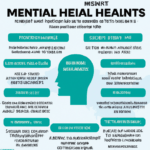Phobias often stem from past traumatic experiences, conditioned responses, or genetic predispositions. Traumas can trigger irrational fears. Genetic factors may contribute to phobias since they run in families. Certain phobias can be learned through observation or personal experiences. Psychoanalytic theory suggests that phobias serve as defense mechanisms. Fear becomes irrational when it interferes with daily life activities. Seeking therapy can help individuals manage and overcome their phobias. Understanding the root causes of phobias is crucial for effective treatment. By confronting fears gradually, individuals can learn to cope and regain control over their lives.
Table of Contents
(Phobias – Causes, Symptoms, and Treatments and More)
Phobias are intense fears triggered by specific objects or situations. They can develop from various factors, including genetics, traumatic experiences, or learned behaviors. Genetics play a role in predisposing individuals to phobias, as some people may have a higher likelihood of developing certain fears based on their family history. Traumatic experiences, such as being involved in a car accident, can lead to the development of a phobia related to driving or vehicles. Additionally, phobias can be learned through observation, especially during childhood when individuals are more susceptible to picking up fears from their environment. For example, seeing a family member react fearfully to spiders can instill a phobia of spiders in a child. The amygdala, a part of the brain responsible for processing emotions and triggering the body’s response to fear, also plays a crucial role in the development of phobias. When the amygdala perceives a threat, it can initiate the body’s fight-or-flight response, leading to extreme fear and anxiety in phobic individuals. Overall, phobias are complex psychological conditions influenced by a combination of genetic, environmental, and neurological factors.
Brain chemistry
The brain chemistry plays a crucial role in the development of phobias. When facing a perceived threat, the brain releases chemicals triggering the fight-or-flight response. This response is essential for survival but can become amplified in individuals with phobias. Excessive levels of neurotransmitters like adrenaline may cause irrational fear responses. These heightened levels can lead to the association of fear with specific triggers, creating phobias. Imbalances in neurotransmitters such as serotonin and dopamine can also contribute to the development of phobias. Serotonin helps regulate mood and anxiety levels, while dopamine impacts reward and pleasure centers in the brain. When these neurotransmitters are imbalanced, individuals may be more prone to developing phobic responses. Furthermore, studies suggest that genetics play a role in brain chemistry and phobia development. Genes can influence neurotransmitter levels, affecting how individuals respond to fear-inducing stimuli. Environmental factors can also impact brain chemistry and phobia development. Traumatic experiences or learned behaviors can alter neurotransmitter production, leading to phobic responses. Additionally, stress and chronic anxiety can disrupt the balance of neurotransmitters in the brain, contributing to phobia development. Understanding the interplay between brain chemistry and phobias is essential for effective treatment. Therapies that target neurotransmitter imbalances, such as medication or cognitive-behavioral therapy, can help individuals manage their phobias. By addressing underlying chemical imbalances in the brain, individuals can learn to cope with their fears and lead more fulfilling lives. Overall, recognizing the role of brain chemistry in phobia development is crucial for developing personalized treatment strategies and improving outcomes for individuals struggling with phobias.
Cultural influences
Cultural influences play a significant role in the development of phobias. The society we grow up in shapes our beliefs and perceptions. Certain cultures may emphasize specific fears or superstitions, influencing individuals’ fears. For example, in some cultures, black cats are considered bad luck. Growing up hearing these beliefs can instill fear of black cats in individuals. Cultural practices and traditions also play a role in shaping fears. Exposure to certain rituals or events may trigger phobias later in life. Moreover, cultural stories and folklore can contribute to the development of specific fears. Tales of mythical creatures or spirits can create fear and anxiety in individuals. Additionally, societal norms and expectations can impact the development of phobias. Pressure to conform to social standards may lead individuals to develop fears related to social situations. For instance, fear of public speaking can stem from the pressure to perform well in front of others. Overall, cultural influences can significantly impact the development of phobias, highlighting the complex interplay between society and individual fears.
Environmental factors
Environmental factors play a significant role in the development of phobias. Experiences that occur in a person’s surroundings can contribute to the onset of irrational fears. A traumatic or distressing event, such as being in a car accident, can lead to a specific phobia related to driving or vehicles. Witnessing a loved one experience a phobia can also influence an individual to develop the same fear. Exposure to certain situations or objects in the environment can trigger a sense of fear or anxiety in some people, leading to the development of phobias. For example, someone who encounters a spider infestation in their home may develop arachnophobia, a fear of spiders. Additionally, societal and cultural factors can play a role in the development of phobias. Social learning theory suggests that individuals may acquire phobias through observation and modeling of others’ fearful behaviors. This can occur within families, peer groups, or through media exposure. Cultural beliefs and norms can also shape the way phobias are perceived and experienced within different societies. For instance, in some cultures, certain animals or objects may be associated with negative connotations, leading individuals to develop phobias related to these specific triggers. Climate and geographical location can also impact the development of phobias. Individuals living in regions prone to natural disasters may develop phobias associated with these events, such as tornadoes or earthquakes. Similarly, environmental changes, such as urbanization or industrialization, can introduce new phobia triggers into people’s lives. Overall, environmental factors are a key component in understanding the complex nature of phobias and how they manifest in individuals. By recognizing the influence of the environment on fear responses, we can better address and treat phobias to improve individuals’ quality of life.
(Phobia, Causes, Signs and Symptoms, Diagnosis and Treatment.)
Genetics
Phobias can stem from genetic factors. Scientists are looking into how genes can influence fear. Research suggests that specific genes may contribute to the development of phobias. These genetic variations might make some individuals more prone to anxiety and fear responses. When a person inherits certain genetic traits, they may be predisposed to specific phobias. Understanding the genetic component of phobias could lead to better treatments. Genetic testing may help identify individuals at higher risk for developing phobias. This knowledge could facilitate early intervention strategies to prevent phobia onset. By uncovering genetic links to phobias, scientists hope to provide targeted therapies. The interplay of genes and environment in phobia development is complex. Factors such as upbringing and experiences also play significant roles in phobia development. While genetics may predispose someone to phobias, environmental triggers can exacerbate fears. This combination of genetic predisposition and environmental triggers can fuel phobia development. Addressing both genetic and environmental factors is crucial in treating phobias effectively. By understanding the genetic basis of phobias, we can approach treatment more holistically. Collaborative efforts between geneticists and psychologists are essential for comprehensive phobia management. Overall, genetics is a key piece in the intricate puzzle of phobia causation. This knowledge can ultimately improve the lives of individuals struggling with phobias.
Traumatic experiences
Traumatic experiences can profoundly impact and shape our psyche. These distressing events evoke intense emotions and create lasting imprints on our mental well-being. It is not uncommon for individuals to develop phobias as a result of such harrowing encounters. The human mind, in its attempt to protect itself, may associate specific stimuli or situations with the trauma endured.
Witnessing or experiencing a traumatic event can trigger deep-seated fears and anxieties that manifest as phobias. For instance, someone who survived a violent car accident may develop a phobia of driving or being in vehicles. The fear of reliving the trauma or encountering a similar peril can be overwhelming.
Traumatic experiences vary widely and can include physical harm, emotional abuse, natural disasters, accidents, or witnessing violence. Each person processes trauma differently, leading to a diverse range of phobias. The fear response triggered by past trauma can become entrenched, causing individuals to go to great lengths to avoid triggers associated with their traumatic experiences.
Phobias stemming from trauma often serve as protective mechanisms, albeit at the cost of limiting one’s daily life. Avoidance behaviors, panic attacks, and heightened anxiety are common symptoms experienced by individuals grappling with trauma-induced phobias. The mind’s attempt to shield itself from perceived threats can result in a cycle of fear and avoidance.
Understanding the connection between traumatic experiences and phobias is essential for effective treatment and healing. Therapy, particularly approaches like cognitive-behavioral therapy, can help individuals confront and reframe their fears. By processing the underlying trauma and learning healthy coping mechanisms, individuals can gradually diminish the grip of phobias rooted in past distress.
In conclusion, traumatic experiences play a significant role in the development of phobias. Acknowledging the impact of past trauma on our present fears is crucial for breaking free from the constraints of phobic responses. Through support, therapy, and self-awareness, individuals can navigate the complexities of trauma-induced phobias towards a path of healing and resilience.








